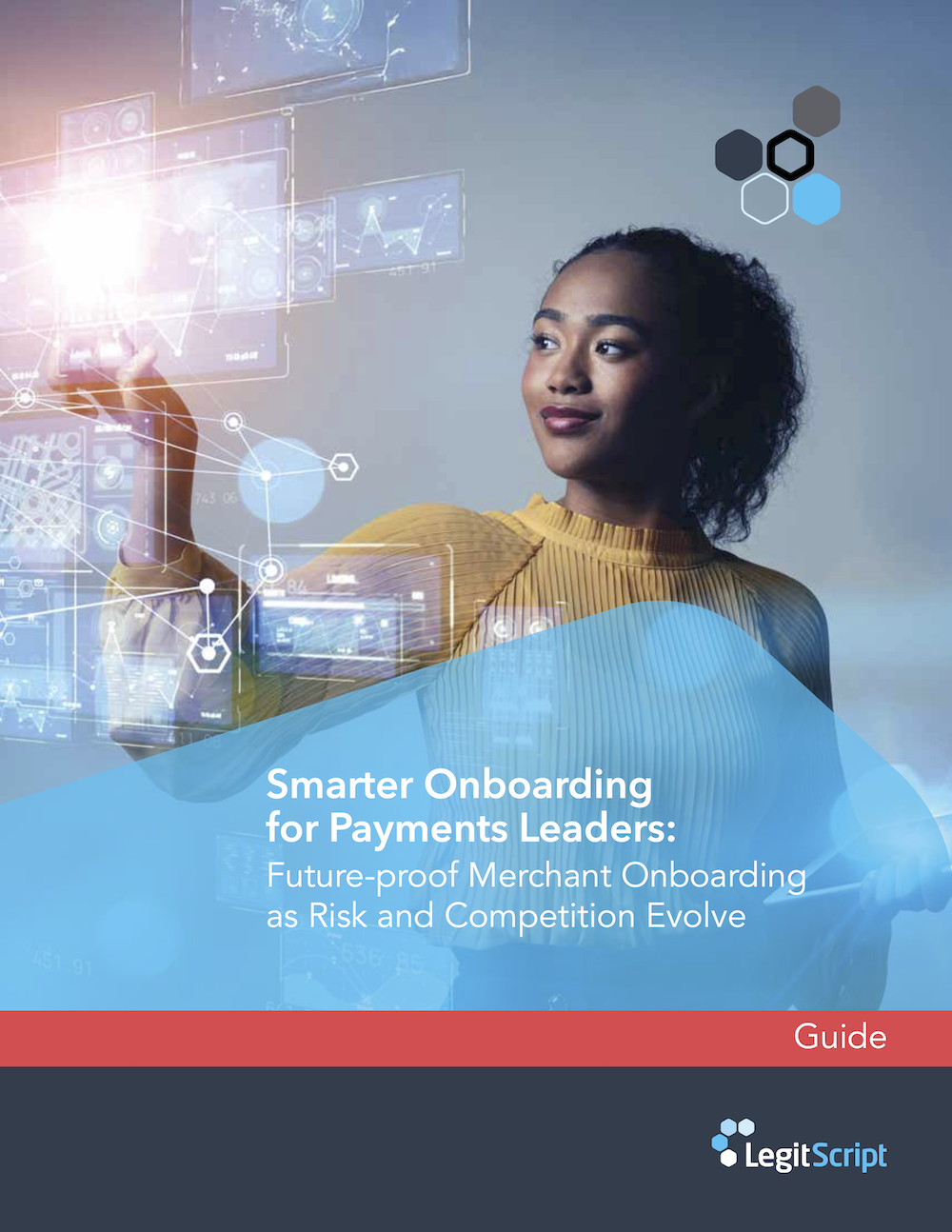Modern merchant onboarding involves much more than collecting documents — it’s about building a smart, scalable risk management process that can keep up with changing technology and fraud tactics. Whether you’re launching a payments platform or refining your underwriting approach, getting onboarding right is crucial for compliance, security, and long-term growth.
Keep reading to understand critical areas of risk, then use our onboarding checklist to ensure your processes are adhering to industry best practices. Learn more by downloading our guide Smarter Onboarding for Payments Leaders.

June 6, 2025 | by LegitScript Folks
Four Critical Risks in Merchant Onboarding
A strong onboarding process offers thorough and flexible risk controls to help protect your platform from a variety of threats. At a minimum, it should screen for these four primary types of merchant risk:
1. Money Laundering & Compliance Risk
Ensure the merchant is a legitimate business, not a front for illegal activity. Your process should:
- Comply with AML (anti-money laundering) laws and card network rules.
- Collect business registration, ownership, and licensing details.
- Run know-your-business (KYB) checks and verify against sanctions lists.
2. Fraud & Transaction Risk
Look out for red flags that signal fraud or financial abuse:
- Analyze fraud history and chargeback rates.
- Check for patterns like transaction laundering or unusual spikes in volume.
- Use transaction history to spot potential abuse of your platform.
3. Reputational Risk
The wrong merchant can hurt your brand. Protect your reputation by:
- Screening for adverse media mentions or ties to controversial activity.
- Avoiding merchants involved in unethical or illegal practices.
- Monitoring for industries or associations that could draw negative attention.
4. Financial (Credit) Risk
If you’re assuming financial liability, assess the merchant’s ability to meet obligations:
- Review creditworthiness, financial statements, and cash flow.
- Examine their ability to fulfill orders and avoid default or chargebacks.
- Gauge the stability and sustainability of their business model.
Key Steps for Effective Merchant Onboarding
Here’s a step-by-step onboarding checklist that reflects current industry best practices. Each step helps you identify potential risk while maintaining efficiency and a good merchant experience.
1. Pre-Screen Applications Early
Catch obvious red flags before investing time in full reviews:
- Validate basic info like website URL and phone number.
- Spot disqualifiers like unsupported business models or fake data.
- Save time by filtering out high-risk or non-serious applicants early.
2. Perform KYB Checks
Know-your-business checks verify that the company is real and properly registered:
- Collect and cross-verify business documentation (e.g., registration, EIN, licenses).
- Identify Ultimate Beneficial Owners (UBOs).
- Check the business name against global sanctions lists.
3. Vet the People Behind the Business (KYC)
Screen UBOs and executives to assess their credibility:
- Verify identity (e.g., ID, selfie match).
- Screen individuals for political exposure, sanctions, or criminal records.
- Search for negative media coverage or connections to fraud.
4. Assess Financial Stability
Evaluate whether the merchant can manage their financial obligations:
- Pull business and principal credit reports.
- Review processing history (volume, chargebacks).
- Analyze bank statements and P&Ls for viability and capital sufficiency.
5. Conduct a Holistic Risk Assessment
Go beyond the basics to understand the full picture:
- Identify high-risk industries or markets.
- Review website content and marketing materials for compliance.
- Use tools such as LegitScript’s Merchant Onboarding to scan for restricted products or misleading claims.
- Assign a risk tier or score based on all available information.
6. Make an Informed Onboarding Decision
Use a structured approach to approval:
- Use automation to flag low-risk for instant approval, and high-risk for auto-decline.
- Manually review edge cases and set conditional terms (e.g., reserves or caps).
- Communicate decisions promptly to deliver a positive experience.
7. Set Up Ongoing Monitoring
Onboarding doesn’t end with approval. Ongoing merchant monitoring is an essential part of maintaining the integrity of your merchant portfolio. After a merchant has been approved:
- Flag merchants for future compliance checks based on initial risks.
- Re-scan high-risk websites and conduct periodic reviews.
- Monitor for changes in behavior or risk indicators.
Best Practices to Strengthen Your Onboarding Process
Use Multiple Data Sources
Don’t rely on one document or database. Cross-verify data points to uncover inconsistencies and reduce fraud risk.
Automate Where It Makes Sense
Automation improves speed and accuracy:
- Automatically pull credit reports, run watchlist checks, and verify registrations.
- Free your team to focus on high-value risk analysis, not repetitive tasks.
Involve the Right Stakeholders
Effective onboarding requires cross-functional collaboration:
- Risk and Compliance teams ensure thorough checks.
- Sales and Product teams optimize the experience.
- Legal and Marketing help align with regulation and brand standards.
Want to Improve Your Onboarding?
A modern onboarding program balances speed, risk management, and merchant experience. By incorporating smart automation, rigorous checks, and continuous monitoring, you can approve the right merchants faster, and stop the wrong ones before they ever go live.
Contact us to discover how to streamline merchant onboarding, fight fraud, and speed up approvals — so you can stay ahead of risk, meet compliance demands, and keep your business moving at the speed of payments.
Smarter Onboarding for Payments Leaders
In this in-depth guide, you’ll learn how payment service providers, ISOs, and acquiring banks can modernize their merchant onboarding workflows to reduce fraud, speed up approvals, and maintain compliance in a rapidly evolving landscape.




